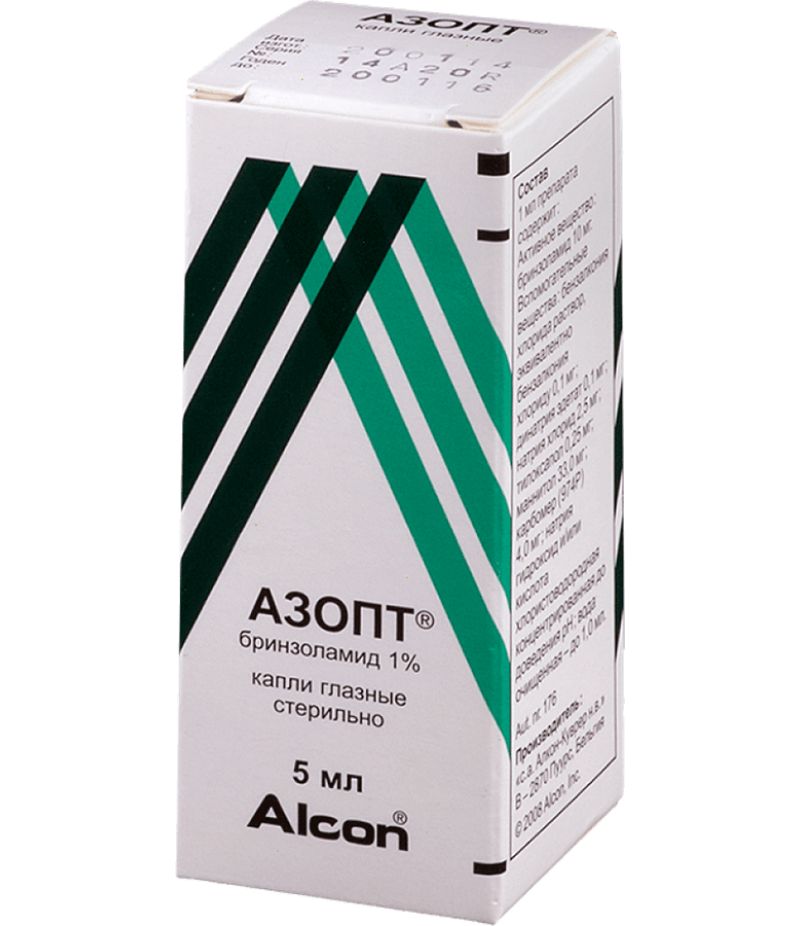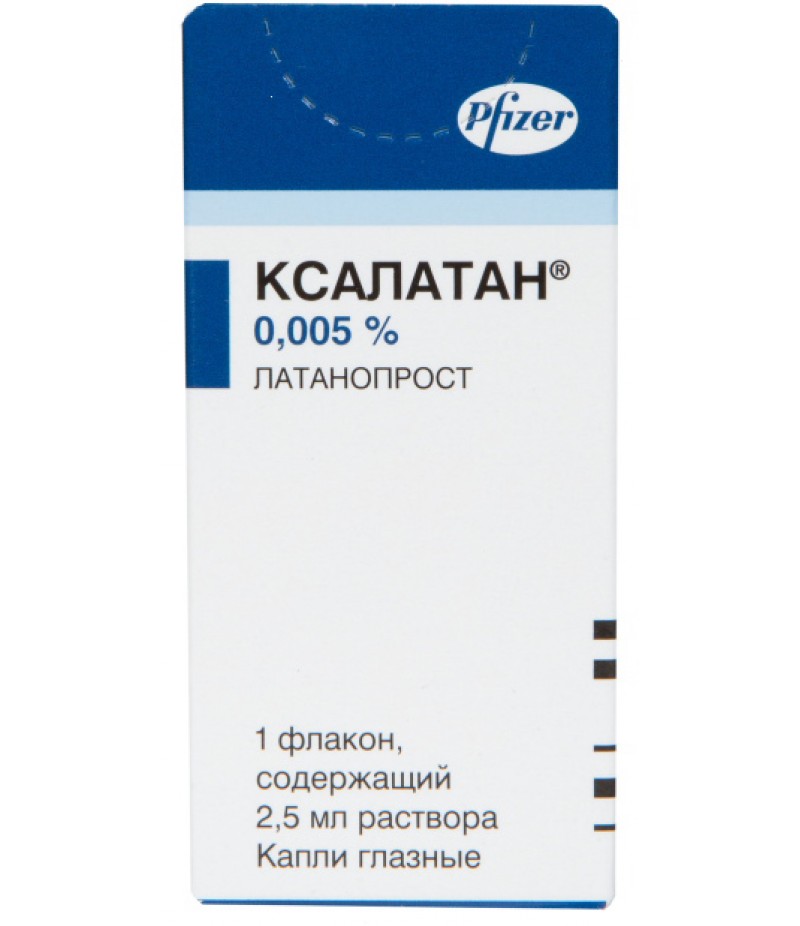Azopt 1% 5ml
- $49.55
- 2 or more $48.90
- 3 or more $47.99
- Availability:In Stock
Instruction for AzoptYou can buy Azopt hereCompositionEye drops Azopt include Brinzolamide as an active substance.In addition, they contain the following additional components: sodium hydroxide and /
Tags: drops
Instruction for Azopt
You can buy Azopt here
Composition
Eye drops Azopt include Brinzolamide as an active substance.
In addition, they contain the following additional components: sodium hydroxide and / or hydrochloric acid, mannitol, sodium chloride, disodium edetate, benzalkonium chloride, tyloxapol, carbomer and water.
Form of issue
The medicine is sold in the form of drops contained in plastic bottles with a dispenser.
pharmachologic effect
Ophthalmologic antiglaucoma preparation.
Pharmacodynamics and pharmacokinetics
The active substance of the drug blocks carbonic anhydrase II, which slows down the formation of bicarbonate ions, and also reduces the transport of sodium and liquid. This causes a decrease in the production of intraocular fluid in the ciliary body of the eye. As a result, intraocular pressure decreases.
The medicine penetrates into the systemic bloodstream. The active ingredient is adsorbed in the red blood cells. A metabolite of N-desethyl Brinzolamide, also accumulating in erythrocytes and binding to carbonic anhydrase, forms.
Half-life time is 111 days. Connection with plasma proteins - 60%.
The active substance and its metabolite excreted unchanged mainly in the urine.
Indications for use
The use of Azopt is indicated to reduce intraocular pressure in the following cases:
open-angle glaucoma;
ocular hypertension.
Contraindications of Azopt
Drops should not be used when:
hypersensitivity to their constituents;
severe violations of kidney function.
In addition, it is undesirable to use the drug in childhood. Safety of its use for children is not established.
With care appoint a medicine to patients:
with a closed angle glaucoma;
with severe liver dysfunction.
The effectiveness of the tool in these cases has not been studied.
When there are signs of drug intolerance, its use must be stopped.
Side effects
Most often, when applying the drug, a bitter taste in the mouth and temporary blurred vision immediately after instillation. Unpleasant taste, most likely, appears because of the penetration of eye drops into the nasopharynx. Dense closure of the eyelids after application of the drug may reduce the likelihood of this reaction.
In addition, when using the drug, in some cases, the following adverse reactions are reported:
infectious diseases: nasopharyngitis, sinusitis, pharyngitis;
Ophthalmic system: pain and foreign body sensation, hyperemia of the eye, blepharitis, irritation and dryness of the eyes, eye itching, discharge from the eyes, corneal erosion, punctate keratitis, a defect of the corneal epithelium, precipitates in the eye, increased intraocular pressure, corneal edema, eye swelling, diplopia, photophobia, blurred vision, hyperemia of conjunctiva, pterygium, asthenopia, abnormal eye sensitivity, hypoesthesia eye, the formation of flakes at the edges of the eyelids, conjunctivitis, increased lacrimation, keratitis, keratopathy, corneal coloring, nar sheniya from the corneal epithelium, the increase in excavation of the optic nerve, meybomianit, photopsia, pigmentation sclera, keratoconjunctivitis sicca, subconjunctival cyst, itching and swelling of the eyelids;
CCC: irregular heart rate, cardio-respiratory distress, bradycardia, angina pectoris;
GI: dry mouth, esophagitis, nausea, indigestion, abdominal discomfort, flatulence, hypoesthesia mouth, diarrhea, vomiting, pain in the upper abdomen, increased intestinal motility, stomach discomfort, paresthesias oral cavity;
skin: hives, rash, baldness, itching, denseness of the skin;
circulatory system: a decrease in the level of erythrocytes, an increase in the number of chlorides in the blood;
CNS: lethargy, mood deterioration, nightmares, anxiety, depression, insomnia, headache, drowsiness, amnesia, dizziness, irritability, impaired motor coordination, memory loss, increased anxiety and fatigue, paresthesia;
Hearing organs: tinnitus;
respiratory system: cough, shortness of breath, pain in the throat and larynx, nasal congestion, sneezing, hyperactivity bronchus, bleeding in the nose, throat irritation, runny nose, dry nose;
musculoskeletal: back pain, myalgia, muscle spasms;
reproductive system: decreased libido, erectile dysfunction;
other: pain in the chest, asthenia.
In case of adverse reactions, the use of drops should be discontinued.
Instructions for Use Azopt (Method and Dosage)
For those to whom Azopt is indicated, the instructions for use indicate that the medicine is dripped 1 drop into the conjunctival sac. You need to do this 2 times every day.
It is recommended to shake the bottle before use. When using the product, care must be taken not to touch the exposed areas with a pipette.
Overdose
In case of topical application, overdose cases are not recorded.
Symptoms of overdose can be as follows: the development of acidosis state, imbalance of electrolytes, nervous system disorders. It is necessary to monitor the level of electrolytes, as well as the pH of the blood.
Interaction
It is undesirable to combine Azopt with carbonic anhydrase inhibitors intended for oral administration, as this increases the risk of side effects. Salicylates in high doses also increase the likelihood of unwanted reactions.
The drug can be used together with other local ophthalmologic agents, but in this case, the minimum interval between their use is 10 minutes.
Storage conditions
Optimum temperature - 4-30 ° C, protect from small children.
Shelf life
After opening the bottle, the drug can be used only for four weeks. Unopened vial is suitable for use for 2 years.
Reviews about Azopt
Patients leave basically positive responses about Azopt. However, they often report the occurrence of side effects. Basically, those who used this remedy, complain about redness of the eyes, increased blood pressure, dizziness, headaches, pain in the heart. This indicates that the drug should be used with caution, carefully monitoring the patient's condition.


